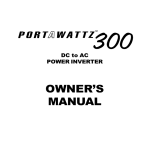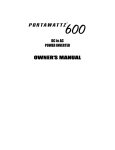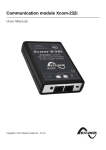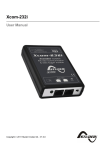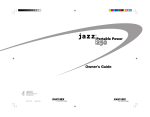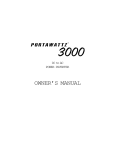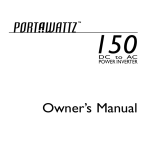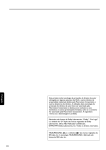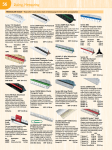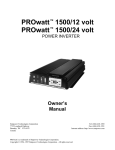Download Table Of Contents
Transcript
Table of Contents 1.0 Introduction ........................................................................ 1 2.0 Safety First Before You Use the PowerPAC .................. 2 3.0 Quick Start Guide .............................................................. 3 3.1 3.2 3.3 3.4 3.5 3.6 Overview .................................................................................................. An Explanation of Power Ratings and Battery Life ...................................... Operating 115 Volt AC Appliances and Equipment ..................................... Operating 12 Volt DC Accessories ............................................................. Recharging the PowerPAC ........................................................................ Using the PowerPAC to Jump-Start Your Vehicle ....................................... 3 4 4 5 5 5 4.0 Indicators, Controls and Connectors ................................ 6 4.1 Display Panel ........................................................................................... 4.1.1 The Battery Level Indicator ............................................................. 4.1.2 The Recharge Indicator .................................................................. 4.1.3 The Charger Input Socket .............................................................. 4.1.4 The DC Power Socket .................................................................... 4.2 The AC Inverter ........................................................................................ 4.3 The High-Power DC Connector ................................................................. 6 6 6 7 7 7 7 5.0 Powering 115 Volt AC Appliances and Equipment ........... 8 5.1 5.2 5.3 5.4 General Information .................................................................................. 8 Connecting Your AC Appliances and Equipment ........................................ 8 Automatic Overload, Overheating and Low Battery Protection .................... 9 Interference with Electronic Equipment ..................................................... 10 5.4.1 Buzzing Sound in Audio Systems .................................................. 10 5.4.2 Television Interference .................................................................. 10 5.5 Battery Operating Times .......................................................................... 11 6.0 Powering 12 Volt DC Accessories ................................... 12 6.1 Connecting 12 Volt DC Accessories ......................................................... 12 6.2 Battery Operating Times .......................................................................... 13 7.0 Vehicle or Boat Engine Starting Assistance .................. 14 7.1 Jump-Starting Direct to the Battery .......................................................... 14 7.2 Jump-Starting via a Vehicles Lighter Plug Socket .................................... 15 PORTAWATTZ PowerPAC is a trademark of Statpower Technologies Corporation. Copyright © 1999 Statpower Technologies Corporation. All rights reserved. 8.0 Recharging the PowerPAC .............................................. 16 8.1 General Information on Batteries and Charging ......................................... 16 8.1.1 Charging Options ......................................................................... 16 8.1.2 Battery Self-Discharge and Shelf Life ............................................ 16 8.2 Recharging with the AC Charger .............................................................. 16 8.3 Recharging from Your Vehicle .................................................................. 17 8.4 Recharging with a Generators 12 Volt DC Power Outlet ............................ 17 8.5 Recharging with a Solar Panel .................................................................. 18 9.0 Connecting to an External Battery ................................. 19 9.1 Extended Operating Time ......................................................................... 19 9.2 Connecting an External Battery ................................................................ 19 10.0 Troubleshooting ............................................................. 20 11.0 Specifications ................................................................ 21 12.0 Limited Warranty (USA and Canada only) .................... 22 13.0 Other Products from Statpower Technologies ............. 24 1.0 Introduction Thank you for purchasing the Statpower PORTAWATTZ PowerPAC (PowerPAC). The PowerPAC is designed for best performance and value in a portable backup power source. It will temporarily power a wide variety of appliances and equipment when utility power is unavailable or during a power outage, and will even jump-start your car in an emergency. Read this manual before using the PowerPAC and save it for future reference. Be sure to charge the PowerPAC immediately after purchase (see Section 8.0). The PowerPACs automatic charging system is intended to be left permanently plugged into a wall outlet, to keep its battery fully charged and ready for use. The following main topics are covered in this manual: How to use the PowerPAC as a source of 115 volts AC to run household or workplace appliances. How to use the PowerPAC as a source of 12 volts DC to run typical auto or marine accessories. How to use the PowerPAC to jump-start a vehicle. How to recharge the PowerPAC battery. PORTAWATTZ PowerPAC Owners Manual 1 2.0 Safety First Before You Use the PowerPAC Misuse of the PowerPAC may result in danger to the user. We urge you to pay special attention to all CAUTION and WARNING statements. CAUTION statements identify conditions or practices that may result in damage to the PowerPAC or to other equipment. WARNING statements identify conditions that may result in personal injury or loss of life. WARNING! Shock hazard. Keep away from children. The PowerPAC generates the same potentially lethal AC power as a normal household wall outlet. Treat it with the same respect that you would any AC outlet. Do not insert any objects into the PowerPACs AC outlets, its DC Power Socket, or the ventilation holes in its AC inverter. Do not expose the PowerPAC to water. Do not, under any circumstances, connect the PowerPAC AC receptacle to power utility AC distribution wiring. Failure to follow the above safety instructions may result in personal injury and/or damage to the PowerPAC. WARNING! Explosion hazard. Do not use the PowerPAC where there are flammable fumes or gases, such as in the bilge of a gasoline powered boat, or near propane tanks. Do not use the PowerPAC in an enclosure containing automotive-type lead acid batteries. These batteries, unlike the sealed battery in the PowerPAC, vent explosive hydrogen gas which can be ignited by sparks from electrical connections. When working on electrical equipment, always ensure someone is nearby to help you in an emergency. WARNING! Heated surface. The PowerPACs AC inverter chassis may become uncomfortably warm, reaching 60° C (140° F) under extended high power operation. Ensure at least 5 cm. (2 in.) air space is maintained on all sides of the PowerPAC. During operation, keep away from materials that may be affected by high temperatures such as blankets, pillows and sleeping bags. CAUTION Do not connect any AC load, whose neutral conductor is connected to ground, to the PowerPAC. Do not expose the PowerPAC to temperatures in excess of 40° C or 100° F. 2 PORTAWATTZ PowerPAC Owners Manual 3.0 Quick Start Guide 3.1 Overview The following basic instructions are intended to get those already familiar with AC inverters and battery packs off to a fast start. But be sure to fully read this manual later! The diagram below shows the PowerPACs key features. Figure 1 PORTAWATTZ PowerPAC Owners Manual 3 3.2 An Explanation of Power Ratings and Battery Life AC powered appliances are rated by how much electrical power (in watts) they consume. The PowerPACs AC inverter is capable of generating a maximum of 300 watts to power appliances plugged into the PowerPACs AC receptacles. As an example, a 40 watt light bulb can be operated from the PowerPAC for up to 3 hours on a fully charged PowerPAC battery. 12 volt DC auto and marine accessories are generally rated according to how much electrical current (in amperes or amps) they draw from the battery. A typical small 12 volt fluorescent light draws 0.7 amps. When connected to the PowerPACs DC Power Socket, this light could be expected to operate up to 40 hours before the PowerPACs battery needs recharging. The PowerPAC is designed to supply up to 12 amps from its DC Power Socket. Remember: The fewer watts an AC appliance uses, or the fewer amps a DC accessory draws, the longer the PowerPAC will operate before recharging is required. 3.3 Operating 115 Volt AC Appliances and Equipment 1. Ensure the PowerPAC battery is fully charged. See Section 8.0 for details. 2. Turn the AC inverter switch ON. The green POWER light indicates AC power is available at the AC outlets. 3. Plug the AC appliance(s) you wish to operate into the AC outlet(s) and switch the appliance(s) ON, one at a time. The PowerPAC will operate most devices rated up to 300 watts. 4. In the event of an overload, low battery voltage, or overheating, the AC inverter will automatically shut down and its red FAULT light will illuminate. See Section 5.3 for details. 5. Fully recharge the PowerPAC battery as soon as possible after each use. 4 PORTAWATTZ PowerPAC Owners Manual 3.4 Operating 12 Volt DC Accessories 1. Ensure the PowerPAC battery is fully charged. See Section 8.0 for details. 2. Plug the accessory into the PowerPACs DC Power Socket, and switch the accessory on (if required). The PowerPAC will operate any 12 volt DC auto or marine accessory that draws 12 amps or less. 3. Because the DC Power Socket is internally wired direct to the PowerPACs battery, extended operation of a 12 volt accessory may result in excessive battery discharge. Important: Care must be taken to ensure the battery does not become totally discharged. See Section 6.1 for details. 3.5 Recharging the PowerPAC 1. The batterys charge condition may be seen by pressing the Battery Status Button on the PowerPACs display panel. 2. To recharge, plug the AC Charger into a household AC outlet, and plug the AC Charger cord into the Charger Input Socket on the PowerPACs panel. The Recharge Indicator will change from amber to green when charging is complete (typically after 30 hours). It is safe to leave the AC Charger connected indefinitely. 3. Charging may also be done from an automobile cigarette lighter. See Section 8.3 for details. 3.6 Using the PowerPAC to Jump-Start Your Vehicle Due to potential dangers, see Section 7.0 for a detailed explanation. PORTAWATTZ PowerPAC Owners Manual 5 4.0 Indicators, Controls and Connectors Refer to Figure 1 in Section 3.1 for location of the items identified below. 4.1 Display Panel The display panel is located on the front of the PowerPAC, directly below its carrying handle. Located on the display panel, you will find the PowerPACs DC Power Socket, the Charger Input Socket, a Recharge Status Indicator light, and a Battery Level Indicator that is actuated by the Battery Status Button. 4.1.1 The Battery Level Indicator The Battery Level Indicator indicates the state of charge of the PowerPACs battery. Its function is similar to the fuel gauge in a car. When pressing and holding the Battery Status Button, one or more of the displays four lights will illuminate, showing the approximate amount of charge remaining in the battery. The following diagram shows the function of each light: When the battery is fully charged, all four lights will illuminate. When discharged (empty), only the red E light will illuminate and the battery must be recharged promptly. The diagram shows the battery is approximately ¾ full. Battery condition is indicated most accurately when the battery has been unused for several minutes. Pressing the Battery Status Button while supplying power to an appliance may result in the battery appearing more empty than it really is. 4.1.2 The Recharge Indicator The Recharge Indicator operates only when the battery is being recharged through the Charger Input Socket. It will not operate when other charging methods are used. When charging the battery with the AC Charger, this light will glow amber, then change to green when the battery is fully charged and the charging process has automatically stopped. 6 PORTAWATTZ PowerPAC Owners Manual 4.1.3 The Charger Input Socket The AC Charger supplied with the PowerPAC connects to this socket when recharging is required. Other low power charging devices can also be connected here. See Sections 8.2 and 8.5 for full details. 4.1.4 The DC Power Socket The DC Power Socket is a cigarette lighter style connector used for powering 12 volt DC auto or marine accessories as explained in Section 6.0, and for recharging the PowerPAC from your cars electrical system as explained in Section 8.3. 4.2 The AC Inverter The front-mounted AC inverter is the heart of the PowerPAC. It converts 12 volts DC supplied by the PowerPACs battery to 115 volts AC power. Two standard AC receptacles mounted on the right side of the inverter supply the AC power to appliances you intend to operate from the PowerPAC. The inverters ON/OFF switch, and its POWER and FAULT indicator lights are mounted on the same side of the inverter as the AC receptacles. A low battery voltage alarm warns you when the inverter has nearly discharged the battery, prior to automatic low voltage shutdown. You will find full details on the inverter, and how to use it, in Section 5.0. 4.3 The High-Power DC Connector The High-Power DC Connector, located on the lower left side of the PowerPAC, is a high current capacity connector wired directly to the PowerPACs battery. The Jump-Start Cable supplied with the PowerPAC connects to the High-Power DC Connector to allow jump-starting of a vehicle in an emergency. Be sure to read Section 7.0 for full details before any attempt is made to use this feature. The High-Power DC Connector can also be used to connect an external battery to the PowerPAC to increase battery capacity. See Section 9.0 for more details. PORTAWATTZ PowerPAC Owners Manual 7 5.0 Powering 115 Volt AC Appliances and Equipment 5.1 General Information The PowerPAC is capable of powering most 115 volt AC appliances and equipment that use 300 watts or less. Its AC output waveform, called a quasi-sine wave or modified sine wave, is designed to function similarly to the sine wave shape of utility power. Most AC appliances rated for 300 watts or less will operate normally from the PowerPAC. CAUTION: Do not use the PowerPAC with the following equipment: Small battery operated appliances such as rechargeable flashlights, some rechargeable shavers, and night-lights that are plugged directly into an AC receptacle to recharge. Certain battery chargers for battery packs used in hand power tools. These chargers will have a warning label stating that dangerous voltages are present at the chargers battery terminals. The power, or wattage, rating of AC appliances and equipment is the average power they use. During the first moments after they are switched on, many appliances such as televisions, monitors, laser printers and appliances with motors, consume much more power than their average rating. Although the PowerPAC can supply momentary surge power greater than 300 watts, some appliances may exceed its capabilities and trigger the inverters safety overload shutdown circuit. See details in Section 5.3 for the reset procedure. If this problem occurs when attempting to operate several appliances at the same time, try first switching on the inverter with all appliances switched off, then one by one switch each on, starting with the high surge appliance first. 5.2 Connecting Your AC Appliances and Equipment The following steps assume you have fully charged your PowerPACs battery. See Section 8.0. 1. Turn on the AC inverter switch located on the inverters right side. The green POWER light that illuminates adjacent to the switch indicates AC power is now on and available at the two inverter AC outlets. See Figure 1 in Section 3.1. 8 PORTAWATTZ PowerPAC Owners Manual 2. Plug the AC appliance or equipment you wish to operate into one of the two inverter outlets and switch the appliance on. The appliance should operate normally, just as it would if plugged into a wall receptacle. 3. As the appliance is operated, you can check the level of the battery as detailed in Section 4.1.1. This will give you an idea of how much time remains until the battery needs recharging. 4. As the battery becomes nearly discharged, or empty, a low voltage warning will sound. This will give you time to shut down a computer, for example. If this warning is ignored, the inverter will switch off automatically a few minutes later to prevent battery damage. See Section 5.3 for full details. 5. Fully recharge the PowerPAC battery as soon as possible after each use. 5.3 Automatic Overload, Overheating and Low Battery Protection The PowerPACs AC inverter has built-in protection against output overload, and from overheating. If an AC appliance rated higher than 300 watts (or which draws excessive surge power at start up) is connected, or if the inverter exceeds a safe temperature, it will automatically shut off. The green POWER light will go off, the red FAULT light will switch on and an alarm will sound. To reset, unplug the appliance and let the inverter cool. Then, switch the inverter OFF for 5 seconds, then switch back ON. Normal operation will resume. If the battery is allowed to discharge excessively, damage may occur. To prevent this, the AC inverter has a built-in audible warning that alerts you when the battery is nearly discharged and it is time to recharge the PowerPAC. If this warning is ignored, the inverter will automatically switch off and the red FAULT light will illuminate when the battery reaches empty. Promptly recharge the battery. See Section 8.0. PORTAWATTZ PowerPAC Owners Manual 9 5.4 Interference with Electronic Equipment 5.4.1 Buzzing Sound in Audio Systems Some inexpensive stereo systems and boom-boxes will emit a buzzing sound from their loudspeakers when operating from the AC output of the PowerPAC. This is because the power supply in the equipment does not adequately filter the modified sine wave produced by the PowerPAC inverter. Unless the stereo can be operated directly from the PowerPACs 12 volt DC Power Socket, the only solution is a sound system with a higher quality internal power filter. 5.4.2 Television Interference The PowerPACs AC inverter is shielded to minimize interference with TV signals. In some cases, particularly with weak TV signals, some interference may still be visible in the form of scrolling lines across the screen. In this case, take the following corrective measures: 1. Use an extension cord to position the PowerPAC as far away as possible from the television, antenna and cables. 2. Adjust the orientation of the PowerPAC, television, antenna and cables to minimize interference. 3. Maximize TV signal strength by using a better antenna, and ensure a shielded antenna cable is used. 4. Try a different TV. Different models of TV sets vary greatly in their susceptibility to interference. 10 PORTAWATTZ PowerPAC Owners Manual 5.5 Battery Operating Times Below are typical AC appliances and equipment that may be operated by the PowerPAC with estimated operating times. 115 Volt AC H ousehold Electrical Appliance Examples Estimated Ty pical Power Operating Time (Watts) (H ours) 40 watt li ght bulb 40 3 C ash regi ster 30 4 Laptop computer, i ncludi ng pri nti ng 60 pages wi th an i nkjet pri nter 22 6 Fi replace fan 20 6 TV (5 i nch color) 20 6 Electri c fan (8 i nch) 15 10 Fluorescent li ght 13 10 Electri c heati ng pad 45 16* C lock radi o 8 22 C ordless phone 5 40 Securi ty alarm 5 40 C amcorder 5 40 * This appliance uses power intermittently which extends operating time. Operating times will vary depending on the battery charge level and the actual appliance being operated. The PowerPAC will not operate appliances rated at more than 300 watts, such as hair dryers, microwave ovens, and toasters. PORTAWATTZ PowerPAC Owners Manual 11 6.0 Powering 12 Volt DC Accessories 6.1 Connecting 12 Volt DC Accessories The PowerPAC can operate any accessory that is intended to run from a cars cigarette lighter outlet. Simply insert the accessorys plug into the DC Power Socket on the PowerPACs display panel. The PowerPACs DC Power Socket will operate any 12 volt DC auto, marine or other 12 volt accessory that draws 12 amps or less. The following steps assume you have first fully charged your PowerPACs battery according to instructions in Section 8.0. 1. Plug the accessory into the PowerPACs DC Power Socket, and switch the accessory on (if required). 2. The 12 volt appliance should operate until the battery runs out of power. 3. If an accessory that draws more than 12 amps (or which is defective and has a short circuit) is connected, an internal circuit breaker will open after a short time and switch power to the accessory off. If this occurs, unplug the accessory and the breaker will automatically reset after a few seconds. 4. The DC Power Socket does not automatically switch off the load when the battery is discharged. To protect the battery against damage resulting from total discharge, it is strongly recommended that the AC inverter is switched on, even when powering 12 volt accessories only. This will enable the inverters alarm to warn you when the 12 volt accessory has nearly depleted the battery. The power used by the inverter to monitor the battery will be negligible. 5. Fully recharge the PowerPAC battery as soon as possible after each use. 12 PORTAWATTZ PowerPAC Owners Manual 6.2 Battery Operating Times Below are typical DC accessories that may be operated by the PowerPAC with estimated operating times. Operating times will vary depending on the battery charge level and the specific accessory being operated. 12 Volt D C Automotiv e or Marine Accessory E xamples E stimated Ty pical C urrent Operating Time (Amps) (H ours) Spotli ght 8 1 A i r compressor 7 1 C ar vacuum 7 1 12 volt TV /V C R (9 i nch) 5 2 B i lge pump 3 3 2.5 4 2 5 C ellular/P C S phone wi th auto adapter 0.5 30 Fi sh/D epth fi nder 0.5 30 12 volt fluorescent li ght 0.4 40 S mall electri c cooler 12 volt radi o PORTAWATTZ PowerPAC Owners Manual 13 7.0 Vehicle or Boat Engine Starting Assistance 7.1 Jump-Starting Direct to the Battery The PowerPAC may be used to jump-start a 12 volt vehicle or small boat engine using the Jump-Start Cable supplied. Jumpstarting causes very high current surges and possible sparking. Unless care is taken, the possibility of battery explosion exists. Read the safety warnings in Section 2.0 before proceeding, then follow these instructions exactly. Before proceeding, be sure to attach the rubber feet supplied to the recesses in the back of the PowerPAC as shown in Figure 1. 1. Turn off the vehicle or boat ignition, and all accessories. 2. Engage the park or emergency brake and place the transmission in park or neutral. 3. If jump-starting a boat engine, purge the engine compartment and bilge of all fumes before jump-starting. 4. Lay the PowerPAC on its back on a flat stable surface near the battery and clear of all moving parts of the engine. 5. Do not connect the Jump-Start Cable to the PowerPAC yet. Connect its red positive (+) clamp to the positive (+) terminal of the engine battery. WARNING: Connecting to the negative terminal can lead to a battery explosion later in this procedure. The batterys positive terminal is identified as being larger in diameter than the negative terminal. In most vehicles it has a red wire connected to it. Do not proceed until you are sure you have connected to the positive terminal. 6. Connect the black negative (-) clamp to the engine block, cylinder head, or other stationary heavy metal part of the motor, as far from the battery as possible. Do not attach the black negative clamp to the battery terminal. 7. Making sure that the cables are clear of belts and fans, plug the Jump-Start Cable into the High-Power DC Connector on the lower left side of the PowerPAC, and start the engine. 8. If the vehicle fails to crank, unplug the Jump-Start Cable, then disconnect the jumper cable clamps. Ensure that the contact area is clean, then repeat steps 5 through 7. 14 PORTAWATTZ PowerPAC Owners Manual 9. Let the motor run at fast idle for 5 minutes to fast-charge the PowerPACs battery, then while the cable clamps are still connected, unplug the Jump-Start Cable from the PowerPAC. Disconnect the black (negative) cable clamp, and then as a last step, disconnect the red (positive) cable clamp. 7.2 Jump-Starting via a Vehicles Lighter Plug Socket The following simple procedure is often sufficient to start a vehicle when its battery is not completely dead. 1. Connect your vehicles cigarette lighter socket to the PowerPACs DC Power Socket using the DC Charge Cable. You may need to switch the ignition key to the accessory position to energize the cigarette lighter plug. 2. Wait 15 minutes while the PowerPAC partially charges your vehicles battery, then attempt to start the engine. 3. Once the engine starts, leave the PowerPAC connected for at least 5 minutes to recharge its battery. 4. If your engine does not start, attempt to jump-start as described in Section 7.1. PORTAWATTZ PowerPAC Owners Manual 15 8.0 Recharging the PowerPAC 8.1 General Information on Batteries and Charging 8.1.1 Charging Options A variety of charging options are possible with the PowerPAC: Charging with the fully automatic plug it in and forget it AC Charger. Charging from your vehicle as you drive. Charging from a generator equipped with a 12 volt battery charging outlet. Charging from a solar panel. 8.1.2 Battery Self-Discharge and Shelf Life All rechargeable batteries gradually discharge when left standing. Periodic charging is necessary to ensure maximum battery capacity. When the AC Charger is connected via the PowerPACs Charger Input Socket, the circuitry built into the PowerPAC will regulate the charging process, ensuring the battery is always fully charged, but never overcharged. To ensure safe recharging and maximum battery life, charge only with Statpower supplied or approved products. CAUTION: Due to inherent self-discharge, lead acid batteries must be charged at least every 3 months, especially in a warm environment. Leaving a battery in a discharged state, or not recharging every 3 months, risks permanent damage. 8.2 Recharging with the AC Charger Recharging with the AC Charger is a true plug it in and forget it charging method. To use it, follow these steps: 1. Disconnect any 12 volt DC accessories and switch the inverter OFF. 2. Insert the AC Charger plug into the Charger Input Socket on the PowerPACs display panel. 3. Plug the AC Charger into a standard 115 volt AC receptacle. 4. As the PowerPAC charges, its Recharge Indicator will glow amber. A typical recharge may take up to 30 hours. 16 PORTAWATTZ PowerPAC Owners Manual 5. When fully charged, the Recharge Indicator changes to green and charging reduces to a very low maintenance level. 6. The PowerPAC is now fully charged and ready to use. The AC Charger may be left permanently connected. In addition, should your utility power be interrupted, the charging process will automatically restart when power returns. Note: Battery Level Indicator readings will not be accurate until the battery has rested for 15 minutes after charging. 8.3 Recharging from Your Vehicle Using the DC Charge Cable, the PowerPAC can be recharged as you drive. Simply plug either end of the DC Charge Cable into the PowerPACs DC Power Socket, and the other end into the vehicles cigarette lighter socket. Most of the PowerPACs capacity will be restored in 1 to 3 hours while the motor is running. While the automatic charge regulation circuitry in the PowerPAC does not operate with this charging method, most vehicle voltage regulators will ensure the PowerPAC is not overcharged. Disconnect both ends of the DC Charge Cable when the motor is not running. 8.4 Recharging with a Generators 12 Volt DC Power Outlet Recharging the PowerPAC from a generator using the PowerPACs AC Charger is possible, but would require extended generator running time. Since many generators have an auxiliary 12 volt DC output designed for charging 12 volt batteries, using this power source will result in much faster charging. If the generator has a cigarette lighter style connector for its 12 volt output, follow the connection instructions in Section 8.3. If it has any other style of 12 volt connector, the Jump-Start Cable may be used to make the connection as follows: 1. Ensure the generator is not running, and connect the positive (red) Jump-Start Cable clamp to the positive 12 volt generator terminal. Be sure you have connected to the positive generator terminal. 2. Connect the negative (black) Jump-Start Cable clamp to the negative 12 volt generator terminal. 3. Plug the Jump-Start Cable into the PowerPACs High-Power DC Connector and start the generator. PORTAWATTZ PowerPAC Owners Manual 17 Most of the PowerPACs capacity will be recharged in about 1 to 3 hours. Level of charge can be verified using the PowerPACs Battery Level Indicator as explained in Section 4.1.1. CAUTION: The generator output must be intended for battery charging. An unregulated output can damage the battery. 8.5 Recharging with a Solar Panel Small unregulated 12 volt solar panels rated to produce a maximum of 3 amps (or 40 watts) can be used to charge the PowerPAC via the Charger Input Socket. You will need to purchase a standard 5.5 mm OD x 2.5 mm ID DC Coaxial (Barrel Type) Connector to mate with the Charger Input Socket. Connect the solar panels positive (red) wire to the coaxial plugs inner contact and the solar panels negative (black) wire to the plugs outer contact. Once the plug is inserted into the Charger Input Socket and the solar panel is placed in the sun, the PowerPAC will charge automatically just as with the AC Charger (see Section 8.2). A 3 amp solar panel will charge the PowerPAC in about 8 hours in direct sunlight. 18 PORTAWATTZ PowerPAC Owners Manual 9.0 Connecting to an External Battery 9.1 Extended Operating Time Much longer battery operating time is possible when connecting the PowerPAC to a larger external battery. For example, an external 60 amp-hour battery will give approximately 4 times the operating time of the PowerPACs internal battery alone. WARNING: Use a sealed, non-spillable battery for indoor use. Common auto and marine batteries are not suitable for indoor use unless their fumes are vented outdoors. They contain acid, which is hazardous if spilled. Wear eye protection and protective clothing when connecting the PowerPAC to an external battery. 9.2 Connecting an External Battery The external battery is connected using the Jump-Start Cable as follows: 1. Connect the Jump-Start Cable red positive (+) clamp to the positive terminal of the external battery. WARNING: Connecting to the negative terminal can lead to a battery explosion later in this procedure. The batterys positive terminal is identified as being larger in diameter than the negative terminal. Do not proceed until you are sure you have connected to the positive terminal. 2. Connect the Jump-Start Cable black negative (-) clamp to the negative terminal of the external battery. 3. Plug the Jump-Start Cable into the PowerPACs High-Power DC Connector. Ensure this step is done last. 4. Disconnect the external battery in the reverse order of the above steps before recharging it. PORTAWATTZ PowerPAC Owners Manual 19 10.0 Troubleshooting Problem: Appliance will not operate, inverter red FAULT light is on. P ossible C ause S uggested R emedy A ppl i ance rated m ore than 300 watts, safety overl oad ci rcui t has tri pped. Use an appli ance wi th a power rati ng less than 300 watts. A ppl i ance i s rated l ess than 300 watts, hi gh starti ng surge has tri pped overl oad. A ppli ance may exceed the P owerPA C 's surge capabi li ty. Use an appli ance wi th starti ng surge power wi thi n the P owerPA C 's capabi li ty. B attery i s di scharged (al arm i s soundi ng). Turn off all appli ances and recharge battery. Inverter has overheated due to poor venti l ati on (al arm i s soundi ng). Turn i nverter OFF and allow to cool for 15 mi nutes. C lear blocked fan, or remove objects coveri ng P owerPA C , then restart. Problem: Run time is less than expected. P ossible C ause S uggested R emedy PowerPAC battery i s not ful l y charged. Recharge usi ng A C C harger, unti l Recharge Indi cator i s green. Appl i ance power consum pti on i s hi gher than expected. C heck appli ance power or "wattage" rati ng (or current draw for D C accessori es) and compare wi th tables i n S ecti ons 5.5 and 6.2. Problem: Measured inverter output voltage is too low. P ossible C ause S uggested R emedy U se of standard "average" readi ng AC vol tm eter to read output vol tage. "Modi fi ed-si ne wave" output of i nverter requi res "true RMS " readi ng meter, such as Fluke 87 seri es multi meter, for accurate measurement. B attery i s al m ost "em pty". C heck B attery Level Indi cator and recharge battery as needed. Problem: Charging light is OFF when AC Charger is connected. Possible C ause Suggested R emedy N o AC power at wal l receptacl e. 20 Ensure power i s avai lable at receptacle. PORTAWATTZ PowerPAC Owners Manual 11.0 Specifications 1 2 Vo l t D C Se ct i o n Internal battery type Internal battery voltage (nomi nal) Internal battery capaci ty C ycle li fe at 100% di scharge/recharge cycles at 20ºC Maxi mum load current through 12 volt D C P ower S ocket (breaker protected) S ealed lead aci d 12 volts D C 18 amp-hours 250 cycles 12 amps I n v e rt e r ( 1 1 5 Vo l t A C ) Se ct i o n A C output voltage (nomi nal) 115 volts A C Maxi mum conti nuous A C output power 300 watts Maxi mum A C surge power 500 watts A C output frequency 60 Hz ± 4Hz A C output waveform Modi fi ed si ne wave Inverter no-load current (battery drai n wi th no load on i nverter) A mbi ent operati ng temperature range 0.18 amps 0ºC - 40ºC / 32ºF - 100ºF Low battery alarm tri gger poi nt 10.7 volts (nomi nal) Low battery shut down poi nt 10.0 volts (nomi nal) C h a r g i n g S ys t e m A C charger bulk chargi ng current 500 mA (maxi mum) B ulk charge to float charge transi ti on voltage (peak chargi ng voltage) 14.6 volts (nomi nal) Float charge to bulk charge transi ti on voltage (charge restart voltage) 12.9 volts (nomi nal) Float charge current (after full charge has termi nated) C harger Input S ocket maxi mum current PORTAWATTZ PowerPAC Owners Manual 1mA (nomi nal) 3 amps 21 12.0 Limited Warranty (USA and Canada only) What Does This Warranty Cover? Statpower manufactures its products from parts and components that are new or equivalent to new, in accordance with industry standard practices. This warranty covers any defects in workmanship or materials. How Long Does The Coverage Last? This warranty lasts for 12 months from the date of purchase. Implied warranties of merchantability and fitness for a particular purpose are limited to twelve months from date of purchase. Some jurisdictions do not allow limitations on how long an implied warranty lasts, so the above limitation may not apply to you. What Does This Warranty Not Cover? This warranty will not apply where the product has been misused, neglected, improperly installed, physically damaged or altered, either internally or externally, or damaged from improper use or use in an unsuitable environment. Statpower does not warrant uninterrupted operations of its products. Statpower shall not be liable for damages, whether direct, incidental, special, or consequential, or economic loss even though caused by the negligence or fault of Statpower. Some jurisdictions do not allow the exclusion or limitation of incidental or consequential damages, so the above limitation or exclusion may not apply to you. What Will Statpower Do? With the exception of the internal battery which is warranted on a Pro Rata basis, Statpower will, at its option, repair or replace the defective product free of charge. Statpower will, at its own option, use new and/or reconditioned parts made by various manufacturers in performing warranty repair and building replacement products. If Statpower repairs or replaces a product, its warranty term is not extended. Statpower owns all parts removed from repaired products. What Will Statpower Do To Remedy A Battery Defect? Statpower will replace a battery free of charge, should it be found defective within 30 days of purchase. During the balance of the 12 month warranty period, Statpower will apply a standard pro-rated charge based on the retail price of the battery. As an example, if found defective within 4 months, the pro-rated replacement charge of 4/12ths of the battery retail price plus any applicable taxes will be charged. Battery defects resulting from improper charging and/or sulphation due to leaving in a discharged state will not be covered under this warranty. 22 PORTAWATTZ PowerPAC Owners Manual How Do You Get Service? In order to qualify for the warranty, dated proof of purchase must be provided and the product must not be disassembled or modified without prior authorization by Statpower. If your product requires warranty service, please return it to the place of purchase along with a copy of your dated proof of purchase. If you are unable to contact your merchant, or the merchant is unable to provide service, contact Statpower directly: BY PHONE: BY FAX: BY EMAIL: (604) 420-1585 (604) 420-1591 [email protected] You must obtain a Return Authorization Number from Statpower before returning a product directly to Statpower. Do not return a product to Statpower without first obtaining a Return Authorization Number. When you contact Statpower to obtain service, be prepared to supply the serial number of your product and its date of purchase. If you are returning a product from the USA or Canada, follow this procedure: 1. Obtain a Return Authorization Number and a shipping address from Statpower. 2. Package the unit safely, preferably using the original box and packing materials. Include the Return Authorization Number, a copy of your dated proof of purchase, a return address where the repaired unit can be shipped, a contact telephone number, and a brief description of the problem. 3. Ship the unit to the address provided in Step 1, freight prepaid. How Other Laws Apply: This warranty gives you specific legal rights, and you may also have other rights which vary from jurisdiction to jurisdiction. For Our Canadian Customers: When used herein implied warranties of merchantability and fitness for a particular purpose includes all warranties and conditions, express or implied, statutory or otherwise, including without limitation implied warranties and conditions of merchantability and fitness for a particular purpose. PORTAWATTZ PowerPAC Owners Manual 23 13.0 Other Products from Statpower Technologies Statpower develops, manufactures and markets power electronic products. Our goal is to offer you top quality products that convert and control electric power. We specialize in DC to AC inverters, battery chargers, backup power supplies and other products associated with mobile or power backup applications. PORTAWATTZ 140 Inverter An extremely compact and versatile inverter, the Portawattz 140 provides 140 watts of AC power for running everything from compact TVs and VCRs to laptop computers. It is also ideal for recharging many of the battery-operated devices found on the market today (e.g. camcorders, cellular phones, etc.) PORTAWATTZ 300 Inverter A higher power product than PORTAWATTZ 140, the PORTAWATTZ 300 delivers 300 watts of AC power yet is still small enough to hold in the palm of a hand. Ideal for small power tools, full size TV sets, desktop computers and other applications that are beyond the power capacity of the PORTAWATTZ 140. PORTAWATTZ 600 Inverter Designed for recreational and industrial applications, the PORTAWATTZ 600 produces 600 watts of continuous power from a 12 volt DC source, and can run loads ranging from power tools to bread makers. It is also ideal for operating a computer, printer, and fax machine simultaneously. PORTAWATTZ 1000 Inverter A compact 1000 watt DC to AC inverter designed for installation in trucks, vans, boats and RVs. This inverter can operate tools and equipment that require less than 800 watts of continuous output power. PORTAWATTZ 1750 Inverter A compact 1750 watt DC to AC inverter designed for permanent installation in a boat, vehicle, or remote home. This inverter can operate power tools, kitchen appliances, and a wide range of other electrical and electronic equipment. PORTAWATTZ 3000 Inverter The perfect inverter for running multiple loads simultaneously, or for starting tough motor-driven loads. The PROsine line of True Sine Wave Inverters and InverterChargers High tech, high power, high efficiency, True Sine Wave output inverters and inverterchargers provide 1000 to 3000 watts at a fraction of the size and weight of older, low frequency technology. The TRUECHARGE line of smart Battery Chargers Microprocessor controlled for precise charging under all conditions, and for maximum battery capacity and life, these full 3-stage battery chargers provide 10 to 40 amps of charging current. Contact your Statpower dealer for more information or check out our web site at http://www.statpower.com. 24 PORTAWATTZ PowerPAC Owners Manual -Notes- -Notes- -Notes- 7725 Lougheed Highway Burnaby, BC Canada V5A 4V8 Tel: (604) 420-1585 Fax: (604) 420-1591 Website: www.statpower.com Part No. 445-0087-01 Rev. 2
































